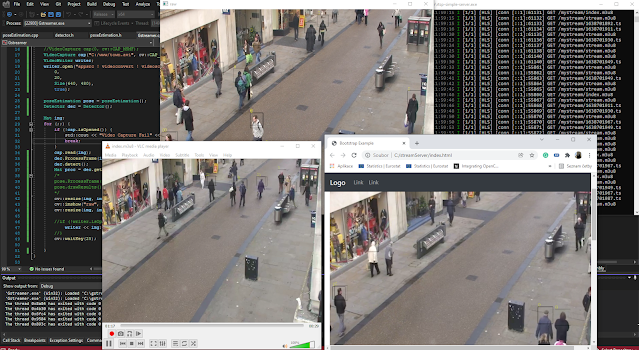Aggregate channel features ACF Pedestrian Detector
This 10 channels are relatively simple to extract mainly by sobel derivatives (cv::sobel).
Yes, the implementation is mainly based on Opencv.
I am using this model param int modelRows = 88;
int modelCols =modelRows/4;
Init features are randomly generated. This is funny part. In some cases program hold 5GB is Ram memory and can cause shutdown of my PC. I cant find why. :)
Now, I am trying different approach of weak feature selectors by AdaBoost, GentleBoost, WaldBoost .
This is only personal research.
In our applications.
Waldboost on Haar + LBP features + Kalman are fast and good enough for me.
I know that Opencv Contrib module has ICF ACF feature extractor and Detector learned by waldboost. After some testing i try to implement my own version and this is the first results.
Adaboost ACF learning details
- I am using Adaboost 1000 weak classifier,
- Ped dataset is my own. 10 000 positive samples. I am working on this dataset time to time for more than 2 years.
- 8 000 Neg samples are generated randomly from my Travel pictures :)
Yes first results after 6 months.
Aggregate channel features first results
In this example is used Town Center Dataset only for demonstration. I can not find any condition of usage on this page. http://www.robots.ox.ac.uk Town Centre Dataset
[1] P.Dollar, R.Appel, S.Belongie and P.Perona. "Fast feature pyramids for object detection". TPAMI, 2014. 1, 2, 7







Hi Vlada, did you publish some of your test code online (for instance on github)?
I would like to. I still have some memory trouble, when I generate random feature structure to evaluate. Get this features is not complicated and right now i am testing this on some other learning algorithm like latent SVM. Code is not so much robust and prepared for public pre release.. Hope, I resolv these tasks soon.
I would like to,but....
Hello
Regarding training the model for ACF.
i want to ask a couple of things:
1) i have a dataset of 10 categories of objects.
the images contain more than one objects. So total positive images are 750 and negative images are 150. How i need to divide the train and test data? 50% each?
2) I am confused that if i want to do object detection than first full dataset is used for the training and testing using ACF for proposal extraction and the again same positive samples use for training and testing for the Object detection?
I am working now on deep learning like any others :).. I put this project under the desk.. Sorry
Hi
Thanks for this post
Have you compared the speed with OpenCV's cascade? Which one is faster?